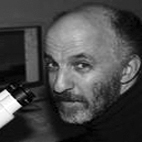Professors Michael Duchen and Francesco Muntoni have been awarded grants to study the cellular mechanisms of a group of muscle diseases called the central core myopathies with a project grant from the Muscular Dystrophy Association (MDA) of $375,000 and a contribution of £69,864 from the Muscular Dystrophy Campaign (MDC) to supplement and extend a BBSRC funded PhD studentship.

Unravelling the role of mitochondrial dysfunction in core myopathies
In this PhD studentship, Prof Michael Duchen and his student aim to study how the genetic fault that causes the core myopathies can affect specialised structures in the cell called mitochondria. They hope this will lead to the identification of new therapeutic targets that can be exploited in the future.
What are the researchers aiming to do?
The core myopathies, which include central core disease and multiminicore disease, are the most common of the congenital myopathies. Symptoms are usually present from birth or early childhood and include floppiness and weakness in the muscles that are closest to the trunk of the body and children often experience delayed motor skills. Multiminicore disease is generally more severe than central core disease and often affects the breathing muscles, which can be life threatening. Central core disease is generally very slowly progressive with individuals having a normal life span and does not usually include the heart of breathing muscles.
When looking under the microscope at muscle biopsies from an individual with one of these conditions, characteristic “cores” can be seen. The “cores” are small areas within the cell where there is an abnormal absence of specialized structures called mitochondria. The mitochondria are the powerhouses of the cell. They convert the energy from the food we eat into the type of energy that cells are able to use for their everyday processes, including muscle contraction.
Both central core disease and multiminicore disease can be caused by faults in the gene that carries the instructions for a protein called ryanodine receptor type 1 (RyR1). The RyR1 protein normally functions as a gate allowing calcium to flow out of a structure found inside the cell called the sarcoplasmic reticulum, this flow of calcium is necessary for muscles to contract. If the RyR1 protein is not working correctly this process will be impaired leading to muscle weakness.
Mitochondria also need calcium to function properly. Since the flow of calcium from the sarcoplasmic reticulum is impaired due to the defective RYR1, then it is possible the mitochondria are not getting as much calcium as they need to efficiently produce energy. If the mitochondria are impaired by the lack of calcium, this could further compound the muscle weakness since the muscles will have insufficient energy to contract.
Prof Duchen aims to explore whether the mitochondria might be defective in these conditions and if they could be contributing to the disease. He will employ a variety of cutting edge imaging techniques to look at how the faulty RYR1 might be affecting the amount of calcium being released during muscle contraction and will study how this affects the mitochondria. The team will use muscle cells from animal models of the core myopathies as well as muscle cells from patients with these conditions to visualize, using fluorescent dyes, what is happening to both the mitochondria and the amount of calcium in the cells under different conditions.
How will the outcomes of the research benefit patients?
Fully understanding the molecular mechanisms that underlie a particular condition can be paramount in producing new therapies. This project will increase our understanding of the consequences arising from the fault in the RYR1 gene and could uncover new information about the role that the mitochondria are playing. This in turn could lead to identification of therapeutic targets aimed at compensating for the impairments in RYR1 and the mitochondria.
Background information
The mitochondria are extremely important structures and are found in most of the different types of cell in the body. They are involved in energy production as well as several other processes such as cellular signaling and control of cell death. Different types of cells have different number of mitochondria with some having very few and others having thousands of mitochondria. Muscle cells need lots of energy for contraction, so have lots of mitochondria.
Using fluorescent dyes to visualize the different compartments of cells can highlight all sorts of cellular processes. There are many different ways to do this, but this particular project will use fluorescent dyes that are sensitive to changes in the amount of calcium found in the cell. These special dyes emit light only when they come into contact with calcium which can be detected under a microscope. Researchers can take still pictures or videos of the changes in the amount of calcium. Subtle changes in the amount of fluorescence and therefore level of calcium within the cell can also be measured.
Further information and links
- Read more about central core disease
- Read more about multiminicore disease
- View some of Prof Duchen’s images and videos of cells on his webpages


whoah this blog is great i really like reading your articles. Stay up the good work! You already know, many individuals are hunting round for this info, you could aid them greatly.
Hey! I know this is kinda off topic however , I’d figured I’d ask. Would you be interested in trading links or maybe guest writing a blog article or vice-versa? My website goes over a lot of the same topics as yours and I feel we could greatly benefit from each other. If you’re interested feel free to shoot me an email. I look forward to hearing from you! Fantastic blog by the way!